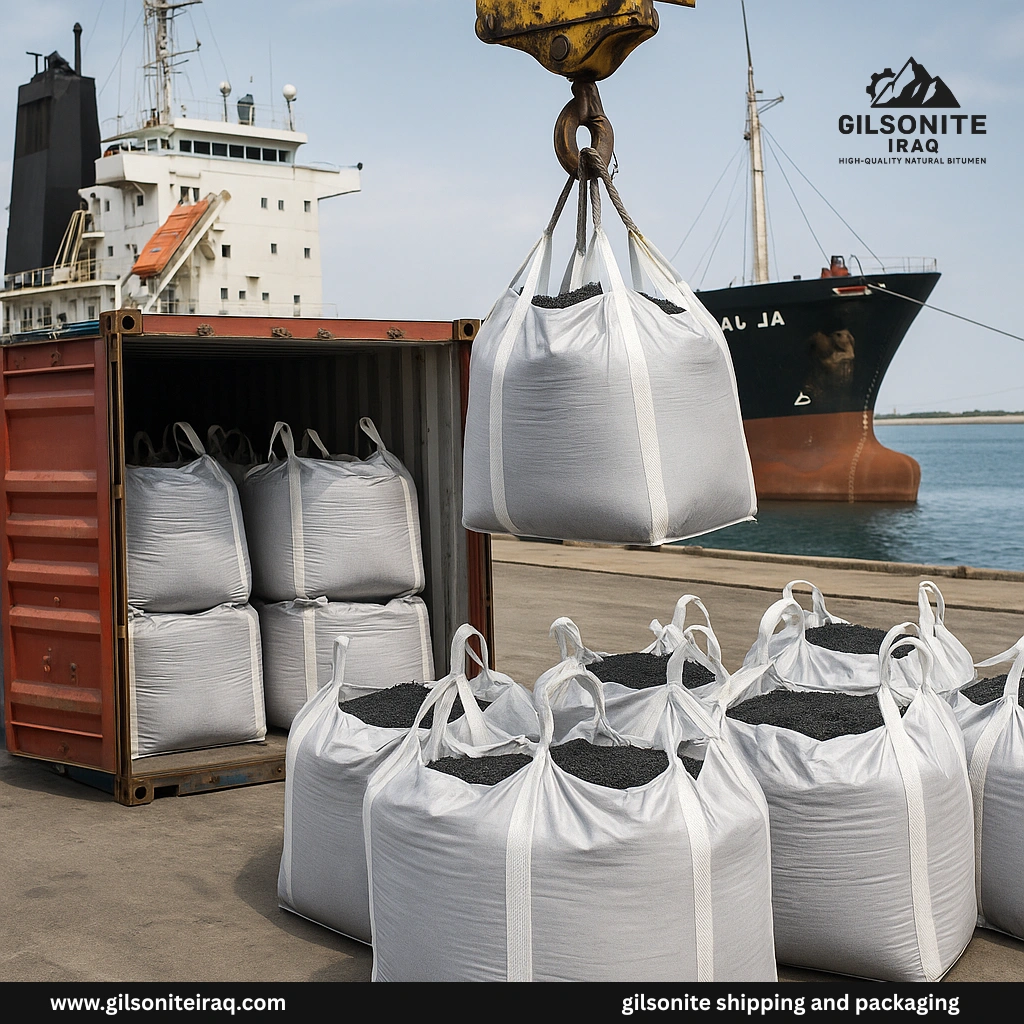Gilsonite — also known as natural asphalt — is a valuable hydrocarbon mineral used in asphalt modification, drilling fluids, and various industrial applications.
Because it is a solid yet fragile material, proper packaging, storage, and shipping methods are essential to preserve its quality and prevent loss during transport.
For exporters, especially in Iraq and the Middle East, optimizing the shipping process not only ensures product safety but also improves customer satisfaction and international competitiveness.
1. Importance of Proper Packaging in Gilsonite Exports
Gilsonite is naturally brittle and can produce fine powder or dust when handled roughly.
Poor packaging can lead to:
- Material degradation during loading and unloading.
- Moisture absorption, which affects purity and solubility.
- Weight variation due to dust loss.
To prevent these issues, exporters use industrial-grade packaging systems designed to protect the material throughout the logistics chain.
(See the ScienceDirect Materials Handling Guide for more on best practices in bulk material packaging.)
2. Common Packaging Types for Gilsonite
Depending on the grade and destination, several types of packaging are used for Gilsonite exports:
| Packaging Type | Description | Best Use |
|---|---|---|
| 25 kg Multi-Layer Bags | PP or Kraft paper with inner PE liner | Small-scale exports or laboratory-grade material |
| 1 MT Jumbo Bags (FIBC) | Woven polypropylene, moisture-resistant liner | Standard form for industrial export |
| Bulk Packaging in Containers | Loose Gilsonite loaded directly in lined containers | Large-volume shipments to nearby markets |
All packaging types should include clear labeling with product grade, batch number, net weight, and handling instructions.
For containerized shipments, inner walls are often covered with plastic or tarpaulin liners to avoid contamination and moisture exposure.
3. Moisture and Dust Control
Gilsonite’s performance depends on maintaining its natural carbon-rich structure.
During transport, changes in humidity can affect product integrity, especially in humid regions or during sea voyages.
To minimize risk:
- Use moisture-proof liners inside jumbo bags.
- Keep storage areas below 50% relative humidity.
- Employ vacuum or shrink wrapping for extended storage.
- Apply anti-dust coatings or surface wetting agents for fine powder grades.
These measures prevent lump softening and protect Gilsonite from external contamination.
4. Shipping Methods and Best Routes
Iraq’s geographical position offers multiple export routes, allowing flexibility and shorter delivery times.
Main shipping methods include:
- Overland transport via the Kurdistan Region to Turkey for European and Mediterranean clients.
- Sea freight through Basra and Umm Qasr ports, ideal for long-distance exports to Asia and Africa.
- Combined transport (road + sea) for optimized cost and transit time.
Exporters like Gilsonite Iraq work closely with freight forwarders and customs agencies to ensure smooth and fast delivery.
(For insights on international freight performance, see the World Bank Logistics Performance Index.)
5. Container Selection and Handling
Proper container selection is crucial to avoid product damage and optimize costs.
| Container Type | Capacity | Recommended Use |
|---|---|---|
| 20 ft Standard Container | Up to 20 metric tons | Ideal for dense Gilsonite flakes or powder |
| 40 ft High Cube | Up to 26 metric tons | For bulk shipments to Asia and Europe |
| Open Top / Flat Rack | Custom loads | Used for large blocks or palletized material |
Handling recommendations:
- Use forklifts with smooth forks to prevent bag punctures.
- Stack bags in uniform layers to ensure stability during transit.
- Secure pallets with stretch film and corner protectors.
- Inspect containers for holes, rust, or moisture residue before loading.
(Refer to the International Maritime Organization Cargo Guidelines for containerized material safety standards.)
6. Labeling and Documentation
Accurate and transparent labeling builds confidence with customs authorities and importers.
Each shipment should include:
- Product details: grade, softening point, and purity level.
- Origin certificate: confirming the Gilsonite source.
- Safety Data Sheet (SDS): outlining handling and storage precautions.
- Export license and invoice: aligned with trade policy requirements.
Iraqi exporters maintain full documentation according to customs and international shipping regulations, reinforcing the professionalism and trustworthiness of the region’s Gilsonite supply chain.
7. Reducing Costs through Logistics Optimization
Efficient packaging and transport planning can reduce overall shipping costs by up to 10–15%.
Cost-saving measures include:
- Consolidating shipments to reduce freight rates.
- Using local bag manufacturers to minimize procurement expenses.
- Coordinating pre-carriage and inland transport with the same logistics partner.
- Implementing real-time tracking systems for container monitoring.
Through these improvements, exporters ensure on-time delivery, lower risk of damage, and stronger customer satisfaction.
Conclusion
Shipping and packaging are critical components of the Gilsonite export value chain.
By following best practices — from moisture protection to labeling and optimized logistics — exporters like Gilsonite Iraq deliver products that meet international standards of quality and reliability.
With strong trade infrastructure, efficient routes, and experienced logistics partners, Iraq continues to lead as a trusted global supplier of natural asphalt.


